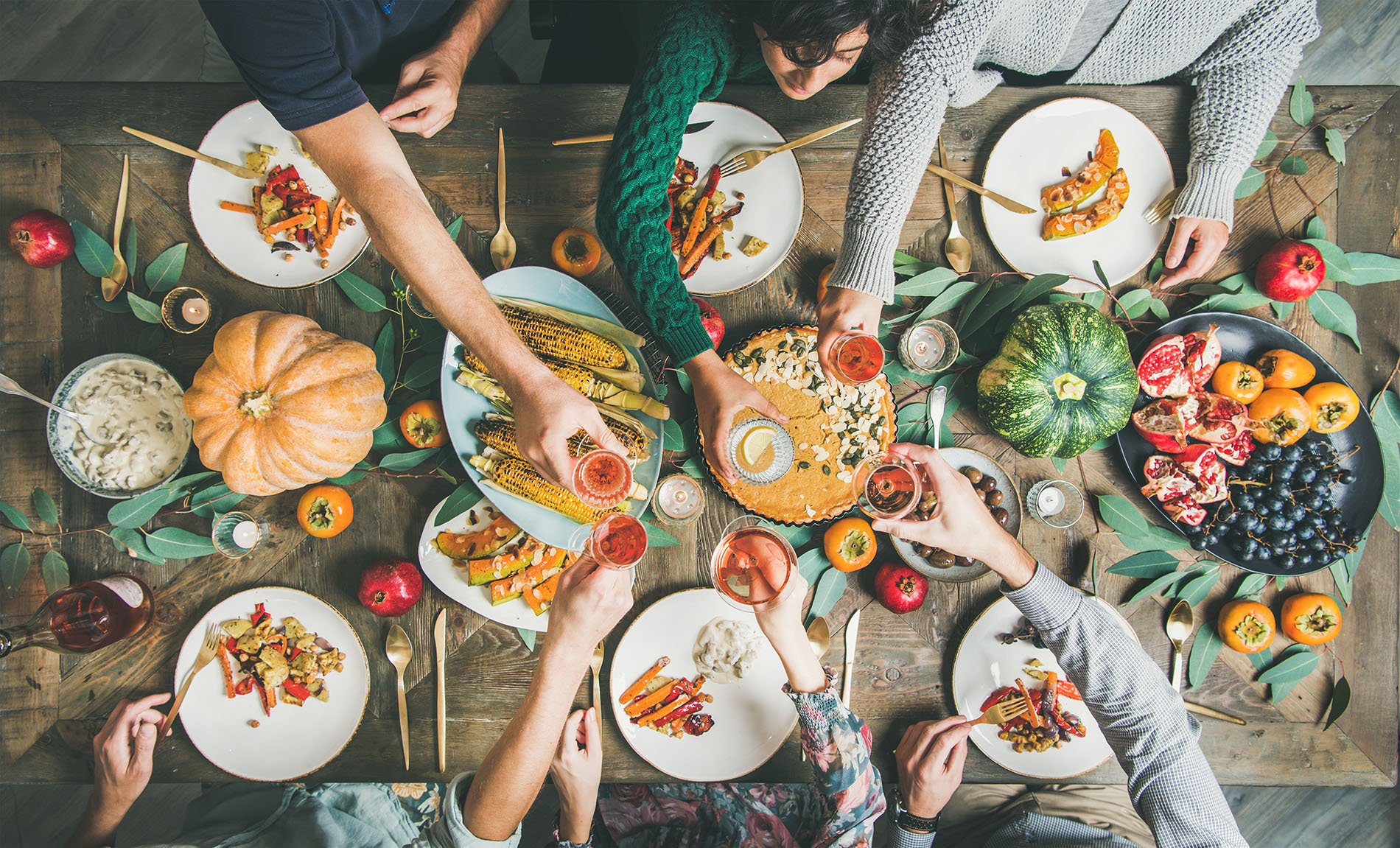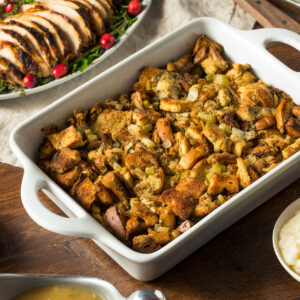Written for Spice Station Silverlake by: Amanda Csolak
When most people think of Thanksgiving, they think about turkey. But for vegetarians, it isn’t about the bird being served, but being saved. As more and more people turn to vegan and vegetarian lifestyles, countless recipes for meat-free Thanksgiving meals can be found online. Here we will talk all about the history behind Thanksgiving and how its changing with the growing popularity of vegetarian and vegan options during this typically turkey celebrated day. Personally, I am thankful for all of nature’s abundance. Later, I’ll highlight my favorite vegetarian entree to serve at Thanksgiving and include the recipe, I can promise you’ll want to add to your recipe box.
Veggies for Thanksgiving
Thanksgiving is changing, and it’s getting more inclusive of vegan and vegetarian choices. As people explore healthier, eco-friendly, and compassionate eating, the Thanksgiving spread is growing with creative plant-based options. So, alongside the classic turkey, you’ll find dishes like Tofurky’s, vegan roasts, and a variety of veggie-based delights. This evolution means there’s something for everyone at the Thanksgiving table, making it a celebration that caters to different tastes and values.
Thanksgiving’s History with Food
After surviving a tough first winter in the New World, the Pilgrims decided to throw a three-day “harvest celebration” in 1621, which we now know as Thanksgiving. According to food historians, their original feast featured veggies like onions, beans, lettuce, spinach, cabbage, carrots, and maybe even peas, along with local fruits like blueberries, plums, grapes, gooseberries, raspberries, and cranberries. Pumpkins were on the menu, but not as pies since they lacked flour, butter, and ovens. They prepared ducks, geese, and swans by boiling and cooking them over a fire. Home-brewed beer added to the festivities, and turkey might have made an appearance.
In 1941, Congress made Thanksgiving an official holiday, celebrated on the fourth Thursday of November. Then, in 1947, the National Turkey Federation started the tradition of gifting one live turkey and two dressed turkeys to the President, who “pardons” one of them, allowing it to live on a historical farm. Unfortunately, the dressed turkeys aren’t as fortunate (by dressed, we mean filled with dressing).
While many folks still include turkey on their Thanksgiving tables, approximately 46 million turkeys are consumed on this holiday, often affectionately called “Turkey Day.” Nevertheless, more and more people are veering away from this tradition for reasons related to health, animal welfare, or the environment. Instead, they’re exploring a bounty of mouthwatering whole food, plant-based dishes that tantalize the taste buds.
The Introduction of Tofurky
Thanksgiving has come a long way for vegetarians over the years. Gary Abramowitz, the creator of Tofurky’s, realized that traditional Thanksgiving feasts often left vegetarians with little more than mashed potatoes and turnips. So, in 1990, he took matters into his own hands, crafting a 14-pound block of bean curd into a turkey shape, marinating it, and roasting it as a protein-packed alternative. What started as a personal experiment soon became a sensation, with Tofurky’s making their way into stores and even grabbing international attention. In recent years, Tofurky’s and Tofu Turkeys have carved out a special place on many vegan and vegetarian holiday tables. These creations, crafted from baked tofu cleverly shaped into the iconic Thanksgiving bird, have become a beloved staple.
The History of the Vegetarian Thanksgiving
Surprisingly the invention of the tofurky was not the invention of the vegetarian Thanksgiving. In fact, the concept of a meat alternative at Thanksgiving dates back over a century before Abramowitz’s invention. In the late 1800s, the Unity School of Christianity in Kansas City, Missouri, led by Charles Fillmore, embraced a plant-based diet and actively promoted vegetarian principles. They even ran a vegetarian cafeteria called the Unity Inn, which published the Unity Inn Vegetarian Cook Book. For their Thanksgiving feast, they offered dishes like “Roast Turkey à la Veg,” a nut loaf made with wheat, walnuts, butter, egg, onion, and spices, showcasing the early roots of plant-based holiday dining.
The Unity group’s choice of vegetarian diets stemmed from their belief that meat was impure and required the body to purify itself to maintain spiritual and eternal equilibrium. Today, science aligns with this perspective, emphasizing the health and environmental benefits of plant-based diets.
As the world moves toward more sustainable eating habits, Unity’s century-old holiday recipes continue to resonate, aligning perfectly with the current emphasis on plant-based foods like grains, legumes, fruits, vegetables, nuts, and seeds recommended by recent UN reports.
The Perfect Spices for Your Vegetarian Thanksgiving
If your looking for the best place to find all the spices you can imagine, than you need to check out Spice Station Silverlake. They have all kinds of spices, from common everyday spices to spices you can’t find anywhere else. Click here to check them out today.
Better Than Turkey: This Meal Will Surprise You
If you’ve been planning your vegetarian Thanksgiving but want to serve something besides tofurky as the main entrée, we have you covered. This recipe I’m going to include below is for an amazing entrée known simple as the Vegetarian Mushroom Wellington. Modeled after the meat filled version, this vegetarian version is easier to make, yet equally impressive.
Seared Portobello mushrooms serve as the hearty base, complemented by apple cider-caramelized onions and sautéed mushrooms seasoned with soy sauce and enriched with walnuts. The luxurious mushroom filling is entirely vegan, and you can easily make the whole dish vegan with a few swaps. Just opt for vegan puff pastry, a butter substitute in the port reduction and caramelized onions, and an egg substitute for brushing the puff pastry. You can even assemble and refrigerate it a day in advance. As the Wellington bakes, whip up the port reduction for an extra layer of flavor, or simply serve it with cranberry sauce for a delightful touch of tart sweetness.
Vegetarian Mushroom Wellington
Total Time: 3 hrs | Yields: 8 Servings
FOR THE MUSHROOM FILLING
- 4 large Portobello mushrooms, each about 3 inches wide (8 to 10 ounces total)
- ½ cup plus 5 tablespoons olive oil
- Kosher salt and smoked black peppercorns, freshly ground
- 2 pounds mixed mushrooms, such as shiitake, oyster and cremini
- Ice, for cooling
- 4 shallots, finely chopped (about 1 packed cup)
- 6 garlic cloves, finely chopped
- 2 tbsp. finely chopped fresh rosemary
- ⅓ cup port, or 1 to 2 tablespoons good-quality aged balsamic vinegar
- 2 tbsp. soy sauce
- 1 tbsp. fresh thyme leaves
- 1 cup finely chopped toasted walnuts (about 4 ounces)
FOR THE ONIONS
- 3 tbsp. unsalted butter
- 2 small yellow onions, cut into ¼-inch rounds
- ¾ tbsp. light or dark brown sugar
- 1¼ tsp. kosher salt
- ¾ tsp. black peppercorns, freshly ground
- 1 cup apple cider or apple juice
- 1 tbsp. good-quality aged balsamic vinegar (optional)
FOR ASSEMBLING
- All-purpose flour, for dusting
- 1(14-ounce) package puff pastry
- 1 large egg, beaten
FOR THE PORT REDUCTION (OPTIONAL)
- 2 tbsp. olive oil
- 1 large shallot, minced
- 2 garlic cloves, minced
- 2 tsp. whole smoked black peppercorns
- 1½ cups good-quality port
- 1½ cups vegetable stock
- 3 fresh thyme sprigs
- 3 tbsp. unsalted butter
- Kosher salt and black pepper
Instructions
Step 1
Wipe the portobello mushrooms clean using moist paper towels. Remove the stems, then slice off the excess rim that curls over the gills, creating a flat surface so the mushrooms can sear. Reserve the stems and scraps for use in Step 2. Brush the caps on both sides with 3 tablespoons olive oil and season generously with salt and pepper. Heat 2 tablespoons olive oil in a large nonstick skillet over medium-high and cook the mushrooms, gill-side down, until caramelized, 5 minutes, then flip and cook another 5 minutes. Transfer to a wire rack, gill-side down, to cool.
Step 2
Prepare the mushroom filling: Separate and reserve any mushroom stems. (If using shiitake mushrooms, save their woody stems for another use.) Roughly chop about two-thirds of the mixed mushrooms, then working in batches, transfer the roughly chopped mushrooms to a food processor and pulse into small, ¼- to ½-inch pieces; transfer to a large bowl. By hand, finely chop the remaining mixed mushrooms and stems (including the reserved portobello mushroom stems and trimmings) into ¼-inch pieces; add them to the bowl.
Step 3
Prepare an ice bath in a large bowl. (If preparing the mushrooms in advance, you can simply let the mixture cool to room temperature, then refrigerate.) Wipe out the skillet. Working in two batches, warm ¼ cup olive oil over medium-high. Add half the mushrooms, shallots, garlic and rosemary, and season with salt and pepper. Cook, stirring occasionally, until caramelized and tender, about 10 minutes. Transfer to a medium bowl. Repeat with the remaining ¼ cup oil and the remaining mushrooms, shallots, garlic and rosemary. Return the first batch to the skillet. Add the port, soy sauce and thyme leaves and cook over medium-high, stirring occasionally, until the liquid evaporates, 3 to 4 minutes. Transfer the mixture back to the medium bowl and stir in the walnuts. Set the bowl over the ice bath to cool, stirring occasionally, at least 20 minutes.
Step 4
Prepare the onions: Wipe out the skillet, then melt the butter over medium heat. Add the onions, sugar, salt and pepper, and cook, stirring occasionally, 5 minutes. Add the cider and cook, stirring occasionally, until the liquid evaporates and the onions are caramelized, about 15 minutes. Stir in the vinegar, if using, then let cool.
Step 5
Heat the oven to 400 degrees. Place a large piece of parchment paper on your work surface and lightly dust it with flour. Unfold your thawed puff pastry on the parchment. Using a lightly floured rolling pin, roll the pastry out into a 13-by-16-inch rectangle. Transfer the parchment paper and puff pastry to a large sheet pan. Rotate as needed so that one of the 16-inch sides is closest to you. Arrange half the cooked mushroom mixture in a 4-by-10-inch strip in the center of the puff pastry, leaving a 1½-inch border at the ends. Arrange the caramelized onions in a 3-inch-wide strip on top. Lay the portobello mushrooms on top of the onions in a single line, stem-side down. (If the portobellos are too large, square off edges.) Spoon the remaining mushroom mixture on top, covering the portobello mushrooms, then gently pack the mushroom mixture to form an even layer on top, shaping it like a freeform meatloaf.
Step 6
Lift one side of the puff pastry over the filling to almost completely cover it. Brush the surface of the puff pastry covering the mushrooms with the beaten egg. Lift the remaining puff pastry flap over the egg-washed puff pastry, gently stretching it if need be to create a second layer of puff pastry on top, then gently press the top layer of pastry onto the lower layer to seal. Brush the insides of the short ends of the puff pastry and press to seal, tucking both sides underneath. Trim any parchment paper that extends beyond the sheet pan. (You can refrigerate the pastry for up to 1 day at this point.)
Step 7
Brush the exposed puff pastry on top with the remaining beaten egg. Decorate the top of the puff pastry as you like: Create a cross-hatch pattern by gently slicing through only the top layer of puff pastry in parallel lines, then cutting parallel lines in another direction. (Apply very little pressure, as you only want to cut through the top layer of puff pastry.) You can also slice small decorative vents (be sure to slice all the way through both layers of puff pastry), or top with additional strips or shapes made from egg-washed puff pastry. Bake until puff pastry is deep golden and flaky, 45 to 50 minutes. Let cool slightly on the baking sheet, about 10 minutes.
Step 8
While the Wellington bakes, prepare the optional port reduction: In a medium saucepan, heat the oil over medium. Add the shallot, garlic and peppercorns, and cook, stirring occasionally, 3 minutes. Add the port, stock and thyme; cook over medium-high until the sauce is glossy, 25 to 30 minutes. Strain the sauce; you should have about ½ cup. When ready to serve, reheat over medium, whisk in the butter, and season with salt and pepper.
Step 9
To serve the mushroom Wellington, cut it crosswise into 8 even slabs. (Each slab will include a pretty cross-section showcasing the halved portobello mushroom in the center; this is considered the presentation side.) Serve each piece presentation-side up. Pass with port reduction for drizzling on top.











